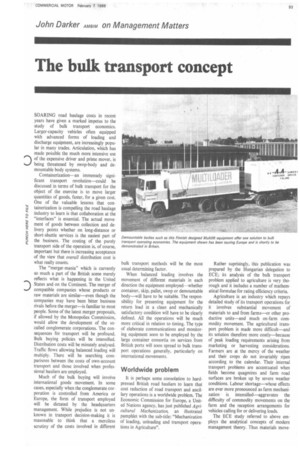The bulk transport concept
Page 95

If you've noticed an error in this article please click here to report it so we can fix it.
SOARING road haulage Costs in recent years have given a marked impetus to the study of bulk transport economics. Larger-capacity vehicles often equipped with advanced forms of loading and discharge equipment, are increasingly popular in many trades. Articulation, which has made poSsible the much more intensive use of the expensive driver and prime mover, is being threatened by swop-body and demountable body systems.
Containerization—an immensely significant transport revolution—could be discussed in terms of bulk transport for the object of the exercise is to move larger quantities of goods, faster, for a given cost. One of the valuable lessons that containerization is compelling the road haulage industry to learn is that collaboration at the "interfaces" is essential. The actual movement of goods between collection and delivery points whether on long-distance or short-shuttle services is the easiest part of the business. The costing of the purely transport side of the operation is, of course, important but there is increasing acceptance of the view that overall distribution cost is what really counts.
The "merger-mania" which is currently so much a part of the British scene merely reflects what is happening in the United States and on the Continent. The merger of compatible companies whose products or raw materials are similar--even though the companies may have been bitter business rivals before the merger—is familiar to most people. Some of the latest merger proposals, if allowed by the Monopolies Commission, would allow the development of the socalled conglomerate corporations. The consequences for transport will be profound. Bulk buying policies will be intensified. Distribution costs will be minutely analysed. Traffic flows allowing balanced loading will multiply. There will be searching comparisons between the costs of own-account transport and those involved when professional hauliers are employed.
Much of the bulk buying will involve international goods movement. In some cases, especially when the conglomerate corporation is controlled from America or Europe, the form of transport employed will be dictated by the headquarters management. While prejudice is not unknown in transport decision-making it is reasonable to think that a merciless scrutiny of the costs involved in different bulk transport methods will be the most usual determining factor.
When balanced loading involves the movement of different materials in each direction the equipment employed whether container, skip, pallet, swop or demountable body—will have to be suitable. The responsibility for presenting equipment for the return load in a clean and mechanically satisfactory condition will have to be clearly defined. All the operations will be much more critical in relation to timing. The type of elaborate communications and monitoring equipment soon to be employed by the large container consortia on services from British ports will soon spread to bulk transport operations generally, particularly on international movements.
Worldwide problem
It is perhaps some consolation to hardpressed British road hauliers to learn that cost reduction of road transport and ancillary operations is a worldwide problem. The Economic Commission for Europe, a United Nations agency, has just published Agricultural Mechanization, an illustrated pamphlet with the sub-title: "Mechanization of loading, unloading and transport operations in Agriculture".
Rather suprisingly, this publication was prepared by the Hungarian delegation to ECE; its analysis of the bulk transport problem applied to agriculture is very thorough and it includes a number of mathematical formulae for rating efficiency criteria.
Agriculture is an industry which repays detailed study of its transport operations for it involves substantial movement of materials to and from farms—or other productive units—and much on-farm commodity movement. The agricultural transport problem is made more difficult—and its solution therefore more costly—because of peak loading requirements arising from marketing or harvesting considerations. Farmers are at the mercy of the weather and their crops do not invariably ripen according to the calendar. Their internal transport problems are accentuated when fields become quagmires and farm road surfaces are broken up by severe weather conditions. Labour shortage—whose effects are ever more pronounced as farm mechanization is intensified—aggravates the difficulty of commodity movements on the farm and the reception arrangements for vehicles calling for or delivering loads.
The ECE study referred to above employs the analytical concepts of modern management theory. Thus materials move












































































































































































